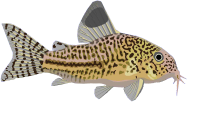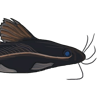Phyllonemus spawning again
-
corybreed
- Expert
- Posts: 919
- Joined: 23 Mar 2004, 23:39
- I've donated: $54.00!
- My catfish: 8
- My cats species list: 74 (i:8, k:0)
- Spotted: 6
- Location 1: Long Island, New York, USA
- Location 2: Long Island
Phyllonemus spawning again
My Phyllonemus have spawned again. Thanks to Sid. The day after I fed them some Guppies the went into the cave. Hopefully this time they will not eat the eggs/fry.
Mark
Mark
- worton[pl]
- Posts: 621
- Joined: 08 Jul 2004, 19:13
- My images: 2
- My cats species list: 11 (i:0, k:0)
- My aquaria list: 3 (i:2)
- Spotted: 1
- Location 1: Lublin, Poland
- Location 2: Warsaw, Poland
- Interests: catfishes, motorcycles
- Contact:
Hiya,
Nicely done Mark! So before you fed guppies they didn't even think about breeding? My are still pretty young (smallest one is about 5cm, biggest about 7cm) but I guess two of biggest fish are mating or something like that :). They swim in circles almost all night, near the back glass where big stone is standing almost reaching the surface :). The rest of my p. typus is just eating and then hide :) so do lophiobagrus.
Anyway gratz for you and your fish :).
Regards.
Nicely done Mark! So before you fed guppies they didn't even think about breeding? My are still pretty young (smallest one is about 5cm, biggest about 7cm) but I guess two of biggest fish are mating or something like that :). They swim in circles almost all night, near the back glass where big stone is standing almost reaching the surface :). The rest of my p. typus is just eating and then hide :) so do lophiobagrus.
Anyway gratz for you and your fish :).
Regards.
Like a true nature's child
We were born, born to be wild
We can climb so high
I never wanna die
Born to be wild
Born to be wild
Steppenwolf, Born to Be Wild
We were born, born to be wild
We can climb so high
I never wanna die
Born to be wild
Born to be wild
Steppenwolf, Born to Be Wild
- sidguppy
- Posts: 3827
- Joined: 18 Jan 2004, 12:26
- My articles: 1
- My images: 28
- My aquaria list: 5 (i:0)
- Spotted: 9
- Location 1: Southern Netherlands near Belgium
- Location 2: Noord Brabant, Netherlands
- Interests: African catfishes and oddballs, Madagascar cichlids; stoner doom and heavy rock; old school choppers and riding them, fantasy novels, travelling and diving in the tropics and all things nature.
- Contact:
Congrats, corybreed!
don't forget to keep on feeding, although small amounts.
the parents exchange eggs and fry several times a day at will, to allow the non-breeding animal to feed; if you "starve" them, they'll swallow the eggs.
sometimes the batch is so large, even both parents breed.
still, once you feed one will take ALL the eggs or fry and will look like its head's about to explode!
once the first has fed it'll take over the entire batch, and the second takes its' feeding turn.
after a few weeks, when the tiny youngsters arrive it'll be 1 week or so when those start to feed: time to hatch live artemia-larvae and get out the cyclops and micro-worms; all of wich can be eaten by the tiny fry.
adding duckweed is a pre; when parents release the young, often the fry goes straight to the surface and hides in there.....easy to catch them. they will need a few daily feeds with artemia/worms/cyclops etc in a tank of their own.
it'll take weeks before baby phyllonemus can be fed with crumbled flake or something; they'd rather starve to death before accepting flake-food at first.
don't forget to keep on feeding, although small amounts.
the parents exchange eggs and fry several times a day at will, to allow the non-breeding animal to feed; if you "starve" them, they'll swallow the eggs.
sometimes the batch is so large, even both parents breed.
still, once you feed one will take ALL the eggs or fry and will look like its head's about to explode!
once the first has fed it'll take over the entire batch, and the second takes its' feeding turn.
after a few weeks, when the tiny youngsters arrive it'll be 1 week or so when those start to feed: time to hatch live artemia-larvae and get out the cyclops and micro-worms; all of wich can be eaten by the tiny fry.
adding duckweed is a pre; when parents release the young, often the fry goes straight to the surface and hides in there.....easy to catch them. they will need a few daily feeds with artemia/worms/cyclops etc in a tank of their own.
it'll take weeks before baby phyllonemus can be fed with crumbled flake or something; they'd rather starve to death before accepting flake-food at first.
Valar Morghulis
-
longstocking
- Posts: 61
- Joined: 24 Oct 2003, 20:40
- My cats species list: 7 (i:0, k:0)
- Location 1: Maryland
- Location 2: Maryland
- Interests: SCUBA
- Contact:
- Barbie
- Expert
- Posts: 2964
- Joined: 03 Jan 2003, 23:48
- I've donated: $360.00!
- My articles: 1
- My images: 15
- My catfish: 2
- My cats species list: 58 (i:2, k:0)
- Spotted: 8
- Location 1: Spokane, WA
- Location 2: USA
-
corybreed
- Expert
- Posts: 919
- Joined: 23 Mar 2004, 23:39
- I've donated: $54.00!
- My catfish: 8
- My cats species list: 74 (i:8, k:0)
- Spotted: 6
- Location 1: Long Island, New York, USA
- Location 2: Long Island
- Barbie
- Expert
- Posts: 2964
- Joined: 03 Jan 2003, 23:48
- I've donated: $360.00!
- My articles: 1
- My images: 15
- My catfish: 2
- My cats species list: 58 (i:2, k:0)
- Spotted: 8
- Location 1: Spokane, WA
- Location 2: USA
- sidguppy
- Posts: 3827
- Joined: 18 Jan 2004, 12:26
- My articles: 1
- My images: 28
- My aquaria list: 5 (i:0)
- Spotted: 9
- Location 1: Southern Netherlands near Belgium
- Location 2: Noord Brabant, Netherlands
- Interests: African catfishes and oddballs, Madagascar cichlids; stoner doom and heavy rock; old school choppers and riding them, fantasy novels, travelling and diving in the tropics and all things nature.
- Contact:
DON'T forget to feed the parent; mysis, mosquitolarvae and the like.
not too much!!! just a bit.
you probably won't see them eating it, so to play it safe it can be a nightly feed.
They WILL eat it, and then the risk of them eating their young is greatly diminished.
remember, this particular fish can and does switch eggs or fry at will, to be able to feed. parents take turns to enable the other to feed.
Do NOT disturb the parents by sticking hands in the tank or lift up caves; this is THE quickest way of screwing up a potential good breeding effort.
you can check on them with a mini-mag or something.
Patience is a virtue here
not too much!!! just a bit.
you probably won't see them eating it, so to play it safe it can be a nightly feed.
They WILL eat it, and then the risk of them eating their young is greatly diminished.
remember, this particular fish can and does switch eggs or fry at will, to be able to feed. parents take turns to enable the other to feed.
Do NOT disturb the parents by sticking hands in the tank or lift up caves; this is THE quickest way of screwing up a potential good breeding effort.
you can check on them with a mini-mag or something.
Patience is a virtue here
Valar Morghulis
-
corybreed
- Expert
- Posts: 919
- Joined: 23 Mar 2004, 23:39
- I've donated: $54.00!
- My catfish: 8
- My cats species list: 74 (i:8, k:0)
- Spotted: 6
- Location 1: Long Island, New York, USA
- Location 2: Long Island




